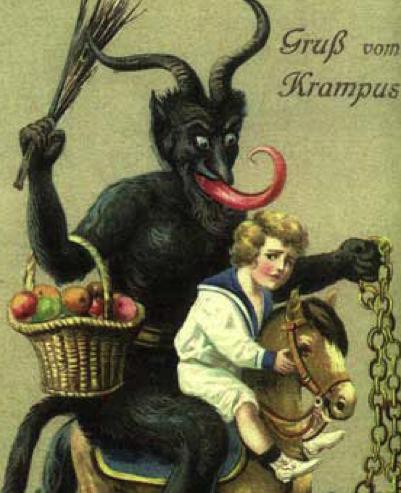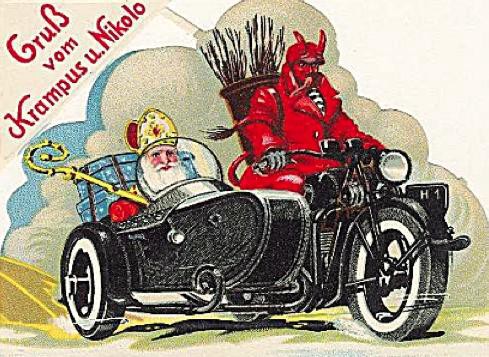Krampus Comes This Weekend! Beware Sinister Saint Nick Sidekicks
by Robert Lanham

Christmas is nearly upon us and, with all its commercialism and saccharine rituals, it’s all too easy to forget the true meaning of the season. Thankfully, the sanctity of this glorious holiday is still appreciated in parts of Germany and Austria where good, hardworking folk remember that Christmas isn’t merely about the gifts; it’s about dressing up like a cloven-hoofed demon, terrifying children with violent, demonic folklore and drinking 180-proof licorice-flavored liquor until you puke.
For centuries, our central European friends have scared the bejesus out of their children with tales of Krampus, a hairy, seven-foot-tall, horned fiend with a suggestive, Gene Simmons-esque tongue who accompanies Saint Nick on Christmas Eve to beat the hell out of naughty children with whips and branches from a birch tree. Like Santa, Krampus carries a satchel, but instead of filling it with presents, he stuffs it with children who have been especially bratty, before tossing them into a molten pit of flesh-charring destruction. Merry Christmas indeed. In some traditions, Krampus was said to make children perform a song or a dance. Those who failed to impress, well, their fate was sealed. Get in the bag! Some believe the myth of Krampus predates Christianity and that families would gather together in one room on the night of his visit, terrified that their children were about to be taken away.
Likely one of the more disturbing creatures you’ll come across in European mythology, Krampus is the water-boarding bad-cop to Santa’s gift-giving good-cop. The Beelzebub to his saint. And assuredly a hell of a deterrent to bad behavior.
Li’l Timmy: But Daddy, I want the new iPad. Why can’t I have it?! Sally’s parents said Santa is going to give her one. I HATE you Daddy. HATE you.
Li’l Timmy’s Father: Son, be quiet. Remember, Krampus can hear you.
Li’l Timmy: [becomes silent, stares at shoes]
Krampus (and “krampus” means “claw”) even has his own holiday referred to as Krampusnacht, The Night of Krampus. In many parts of central Europe, men assemble in pubs and town centers on December 5th dressed as the ungodly beast, flailing with whips and branches those unfortunate enough to pass by. In Schladming, Austria there’s an annual Krampus Karnaval where thousands of drunk, branch-waving men gather adorned in masks and sheep skins in honor of Kris Kringle’s masochistic sidekick.
Reportedly, it’s kind of like Mardi Gras only with young women being terrorized by goat-horned demons instead of Girls Gone Wild mogul Joe Francis.
In less politically correct times, the drunken Krampuses (Krampi?) would travel door to door shouting and banging cowbells. Pushing their way into the homes of townspeople, they would whip local children with branches and refuse to leave until they were appeased with booze. Of course, things still occasionally do get out of hand. Last year in Austria, someone dressed as a Krampus put a thirteen year old in the hospital after choking him, beating him with a stick and ramming his head into a wall.

Though since forgotten, the Krampus myth made its way to America’s sanitized shores in the 1800s, when Germans began importing holiday postcards bearing the image of the supernatural beast. Predictably, some were not amused:
Opinion makers in the American upper classes… were dismayed by this invasion of wild foreign characters and the equally wild festivities they provoked, where crowds of costumed drunkards would break up church services and invade homes, demanding alms and hospitality. In a campaign to domesticate the holiday, intellectuals in the former Dutch colony of New York championed Sinterklaas, the benign Dutch gift giver. Starting with an appearance in Washington Irving’s History of New York in 1809, his wholesome image was refined by a generation of writers into the Santa Claus we recognize today.
By the time the U.S. entered World War I, the Krampus myth had begun to lose even more steam.
When the U.S. entered the First World War in 1917 the import of German holiday cards came to an abrupt stop. The enigmatic European gift givers, the alternative Santas and the sinister sidekicks all disappeared. Styles of child rearing had changed too and modern parents disowned the dark, punitive gift-giver tradition that had fuelled holiday nightmares for so many generations. The jolly fat fellow in red had won the marketing battle and banished the whip-wielding demon.
Not surprisingly, different regions have their own variations on the Krampus myth, and in many cases sinister Santa sidekick traditions of their own. In northern Germany, Santa has a fur-covered sidekick named Belsnickel who, if you’re naughty, will fill your stocking with coal, switches and other crap you don’t want like starlight mints. The Netherlands have Zwarte Piet (aka Black Peter) — a servant of Santa who dresses in blackface and fills children’s shoes with candy. Some traditions claim Black Peter’s ebony color comes from the soot in the chimneys he slides down, but older traditions suggested he was a Moor who would kidnap naughty children and drop them off in Spain to punish them. Um, okay. In France, Santa has a buddy named Le Père Fouettard who notoriously slits three children’s throats before making a holiday stew out of them. You can friend him on Facebook! (Incidentally, some have speculated that Le Père Fouettard is the man featured on the cover of “Led Zeppelin IV.”)
And in more contemporary times, there’s Boehner, an orange-faced scalawag who takes control of the House just prior to Christmas, tries to terminate funding for the unemployed and the arts and terrorizes children by taking part in cover-up scandals
But back to Krampus. Clearly, after a century of overly sanitized “It’s a Wonderful Life”-corncob-pipe-dream-sugar-plum fairy tales, there’s never been a better time for a Krampus revival. Some are already doing their best to reinvigorate the myth. Last year, Stephen Colbert tried to enlist Krampus to the front lines on the War on Christmas. And on Sunday, there’s Cramp-us in the East Village, a celebration of Krampusnacht set to the music of the Cramps. But why not take things further? We’re long overdue for a KrampusCon, which honestly sounds much more interesting and fitting than Santacon anyway. And where’s our definitive Krampus gore-porn film? Silent Night, Deadly Night was great, but who wouldn’t prefer watching Krampus, scored to a peppy piano tune by Vince Guaraldi, drop-kick Justin Bieber and the guy with the mohawk from “Glee” into a fiery abyss?
So, in the spirit of restoring a taste of the macabre to the season, join me December 5, and raise a glass of Krampus Imperial Brown Lager in honor of this long forgotten myth. Merry Krampusnacht!
Robert Lanham is the author of the beach-towel classic The Emerald Beach Trilogy, which includes the titles Pre-Coitus, Coitus, and Afterglow. More recent works include The Hipster Handbook and The Sinner’s Guide to the Evangelical Right. He is the founder and editor of FREEwilliamsburg.com.
